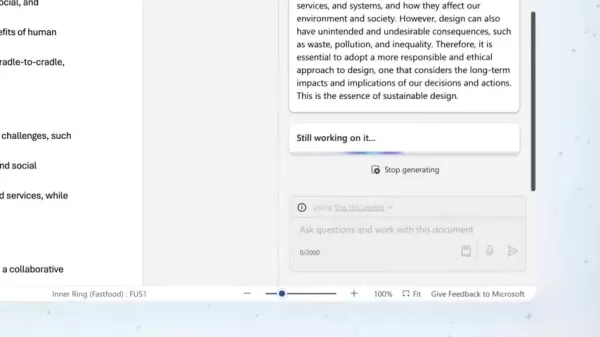Microsoft LAM: Revolutionizing AI with Large Action Models
Exploring Microsoft's Large Action Model (LAM)
Artificial intelligence is constantly evolving, and Microsoft is pushing the boundaries with its innovative Large Action Model (LAM). Unlike conventional language models that merely generate text, LAM is designed to take action directly within the Windows environment. This unique approach aims to connect the dots between AI that understands language and AI that can execute tasks, paving the way for more practical and seamlessly integrated AI solutions.
What is the Large Action Model (LAM)?
Microsoft's Large Action Model, or LAM, isn't just about generating text. It's about getting things done within the Windows ecosystem. Imagine telling your computer to perform a task, and it not only understands but also executes it in applications like Microsoft Word, Excel, and PowerPoint. LAM's goal is to bridge the gap between traditional language models and those that can interact directly with an operating system, making AI more practical and integrated into our daily workflows.

The Development and Design of LAM
The development of LAM focuses on interpreting user instructions and converting them into actionable steps that can be carried out in applications like Microsoft Word, Excel, and PowerPoint. It's all about understanding natural language, translating it into actions, and executing those actions within a software interface. LAM's design emphasizes autonomous task performance, which is great for automating repetitive tasks, streamlining workflows, and boosting overall productivity. This ability to directly interact with Windows applications is what sets LAM apart from other AI models that primarily focus on generating text or providing information.

Bridging the Gap: Language Models and Operating Systems
LAM aims to bridge the divide between language models that only produce text and those that can interact directly with an operating system. This is a game-changer, moving AI beyond simple information retrieval and text generation to actual task execution. By enabling AI to interact directly with the Windows environment, LAM can handle everything from simple formatting in Word to complex data analysis in Excel, making it a versatile and practical tool for users across various fields.

The Training Process of LAM
Training Methodologies: Supervised Fine-Tuning, Imitation Learning, and Reinforcement Learning
The training of LAM involves a mix of supervised fine-tuning, imitation learning, and reinforcement learning. These methods help LAM learn to interpret user instructions, plan actions, and execute tasks effectively. Supervised fine-tuning uses labeled datasets to teach LAM the relationship between language and actions. Imitation learning allows LAM to observe and mimic expert demonstrations, while reinforcement learning helps it learn from trial and error, receiving rewards for correct actions and penalties for mistakes.

Data Sources for Training: Software Documentation, WikiHow Articles, and Bing Search Queries
LAM's training data comes from diverse sources like official software documentation, WikiHow articles, and Bing search queries. These sources give LAM a broad understanding of user needs and how to perform tasks in different contexts. Software documentation provides detailed instructions on using applications like Word and Excel, while WikiHow articles offer step-by-step guides for various tasks. Bing search queries help LAM understand user intent and tailor its responses accordingly.

Data Evolving and the Role of GPT-4
GPT-4 plays a crucial role in structuring raw text into task-plan pairs for LAM's training. It helps add complexity to basic tasks by introducing extra conditions or instructions, enabling LAM to handle a wide range of scenarios and adapt to different user needs. This use of GPT-4 ensures that the training data is high-quality and relevant, leading to better performance.

Building Task-Plan Pairs: Converting Instructions into Actions
One of the key steps in training LAM is converting written instructions into actions that can be executed within Windows. This involves creating task-plan pairs, which consist of a user instruction and the corresponding sequence of actions required to complete the task. For example, a task-plan pair might include the instruction "Highlight the text 'Hello World' in Word" and the actions of selecting the text and clicking the highlight button. Training on these pairs helps LAM map language to actions effectively.

Training Phases: From LAM1 to LAM4
The training of LAM involves multiple phases, starting with a base model called Mistral 7B and progressing through several iterations to LAM4. LAM1 learns to write coherent plans for tasks, while LAM2 can generate action steps by imitating successful examples. LAM3 introduces new ways to solve tasks, and LAM4 uses a reward model to optimize decision-making through reinforcement learning, learning from both successful and failed attempts.

How to Leverage Microsoft LAM in Your Daily Tasks
While LAM is still under development, its potential applications are vast. Here’s how you might use LAM in the future for common tasks:
Task 1: Formatting a Document in Word
User Instruction: "Make the title of this document bold and increase the font size to 16."
LAM Interpretation: LAM identifies the title, selects it, and opens the formatting options.
Action Execution: LAM clicks the bold button and changes the font size to 16.
Task 2: Creating a Presentation in PowerPoint
User Instruction: "Create a new slide with a bullet-point list summarizing the key findings."
LAM Interpretation: LAM adds a new slide and inserts a bullet-point template.
Action Execution: LAM populates the bullet points with a summary of the key findings.
Task 3: Analyzing Data in Excel
User Instruction: "Calculate the average sales for the last quarter."
LAM Interpretation: LAM selects the sales data for the last quarter.
Action Execution: LAM applies the average function and displays the result.
Pros and Cons of Microsoft LAM
Pros
- Automates tasks within the Windows environment.
- Reduces the need for manual intervention.
- Can improve productivity and accuracy.
- Bridges the gap between language models and operating systems.
Cons
- Still under development.
- Requires extensive training data.
- May not be suitable for all tasks.
- Potential for errors in complex scenarios.
Use Cases of Microsoft LAM
Automating Repetitive Tasks with LAM
One of the main uses of LAM is automating repetitive tasks. By understanding user instructions and performing actions automatically, LAM can save time and effort across various domains. Examples include automatically formatting documents, creating reports by extracting data, and managing emails by sorting messages, scheduling meetings, and drafting responses.
Enhancing Productivity with AI-Driven Task Execution
LAM can significantly boost productivity by enabling AI to perform tasks directly within the Windows environment. This eliminates the need for users to switch between applications and perform actions manually, leading to streamlined workflows, improved accuracy, and faster task completion.
Transforming Industries with Actionable AI
LAM has the potential to transform industries by enabling AI to take actionable steps based on user instructions. This opens up new possibilities for automation, decision-making, and problem-solving in sectors like healthcare, finance, and education.
Frequently Asked Questions About Microsoft LAM
What is the primary goal of Microsoft LAM?
The primary goal of Microsoft LAM is to bridge the gap between language models that only produce text and those that can interact directly with an operating system, enabling AI to perform tasks autonomously within the Windows environment.
What training methodologies are used to develop LAM?
LAM is trained using supervised fine-tuning, imitation learning, and reinforcement learning to help it interpret user instructions, plan actions, and execute tasks effectively.
What data sources are used for training LAM?
The training data for LAM comes from a variety of sources, including official software documentation, WikiHow articles, and Bing search queries, providing a broad understanding of user needs and how to perform tasks in different contexts.
How does GPT-4 contribute to the training process of LAM?
GPT-4 plays a crucial role in structuring raw text into task-plan pairs for LAM training and helps add complexity to basic tasks by introducing extra conditions or instructions.
What are the different phases of LAM training?
The training of LAM involves multiple phases, starting with a base model and progressing through several iterations to LAM4, which learns from both successful and failed attempts.
Related Questions About the Future of AI and Microsoft LAM
LAM has the potential to revolutionize how we interact with computers and software. By enabling AI to perform tasks autonomously, LAM can save time and effort, improve productivity, and transform industries. As LAM continues to evolve, it's likely to become an increasingly integral part of our daily lives. However, its widespread adoption also raises important ethical and societal questions, such as ensuring responsible and ethical use, addressing bias, transparency, and accountability.
Related article
 Design Eye-Catching Coloring Book Covers Using Leonardo AI
Looking to design eye-catching coloring book covers that grab attention in Amazon's competitive KDP marketplace? Leonardo AI can help you create professional-grade, visually appealing covers that drive sales. Follow our expert techniques to craft stu
Design Eye-Catching Coloring Book Covers Using Leonardo AI
Looking to design eye-catching coloring book covers that grab attention in Amazon's competitive KDP marketplace? Leonardo AI can help you create professional-grade, visually appealing covers that drive sales. Follow our expert techniques to craft stu
 YouTube Integrates Veo 3 AI Video Tool Directly Into Shorts Platform
YouTube Shorts to Feature Veo 3 AI Video Model This SummerYouTube CEO Neal Mohan revealed during his Cannes Lions keynote that the platform's cutting-edge Veo 3 AI video generation technology will debut on YouTube Shorts later this summer. This follo
YouTube Integrates Veo 3 AI Video Tool Directly Into Shorts Platform
YouTube Shorts to Feature Veo 3 AI Video Model This SummerYouTube CEO Neal Mohan revealed during his Cannes Lions keynote that the platform's cutting-edge Veo 3 AI video generation technology will debut on YouTube Shorts later this summer. This follo
 Top AI Labs Warn Humanity Is Losing Grasp on Understanding AI Systems
In an unprecedented show of unity, researchers from OpenAI, Google DeepMind, Anthropic and Meta have set aside competitive differences to issue a collective warning about responsible AI development. Over 40 leading scientists from these typically riv
Comments (0)
0/200
Top AI Labs Warn Humanity Is Losing Grasp on Understanding AI Systems
In an unprecedented show of unity, researchers from OpenAI, Google DeepMind, Anthropic and Meta have set aside competitive differences to issue a collective warning about responsible AI development. Over 40 leading scientists from these typically riv
Comments (0)
0/200
Exploring Microsoft's Large Action Model (LAM)
Artificial intelligence is constantly evolving, and Microsoft is pushing the boundaries with its innovative Large Action Model (LAM). Unlike conventional language models that merely generate text, LAM is designed to take action directly within the Windows environment. This unique approach aims to connect the dots between AI that understands language and AI that can execute tasks, paving the way for more practical and seamlessly integrated AI solutions.
What is the Large Action Model (LAM)?
Microsoft's Large Action Model, or LAM, isn't just about generating text. It's about getting things done within the Windows ecosystem. Imagine telling your computer to perform a task, and it not only understands but also executes it in applications like Microsoft Word, Excel, and PowerPoint. LAM's goal is to bridge the gap between traditional language models and those that can interact directly with an operating system, making AI more practical and integrated into our daily workflows.

The Development and Design of LAM
The development of LAM focuses on interpreting user instructions and converting them into actionable steps that can be carried out in applications like Microsoft Word, Excel, and PowerPoint. It's all about understanding natural language, translating it into actions, and executing those actions within a software interface. LAM's design emphasizes autonomous task performance, which is great for automating repetitive tasks, streamlining workflows, and boosting overall productivity. This ability to directly interact with Windows applications is what sets LAM apart from other AI models that primarily focus on generating text or providing information.

Bridging the Gap: Language Models and Operating Systems
LAM aims to bridge the divide between language models that only produce text and those that can interact directly with an operating system. This is a game-changer, moving AI beyond simple information retrieval and text generation to actual task execution. By enabling AI to interact directly with the Windows environment, LAM can handle everything from simple formatting in Word to complex data analysis in Excel, making it a versatile and practical tool for users across various fields.

The Training Process of LAM
Training Methodologies: Supervised Fine-Tuning, Imitation Learning, and Reinforcement Learning
The training of LAM involves a mix of supervised fine-tuning, imitation learning, and reinforcement learning. These methods help LAM learn to interpret user instructions, plan actions, and execute tasks effectively. Supervised fine-tuning uses labeled datasets to teach LAM the relationship between language and actions. Imitation learning allows LAM to observe and mimic expert demonstrations, while reinforcement learning helps it learn from trial and error, receiving rewards for correct actions and penalties for mistakes.

Data Sources for Training: Software Documentation, WikiHow Articles, and Bing Search Queries
LAM's training data comes from diverse sources like official software documentation, WikiHow articles, and Bing search queries. These sources give LAM a broad understanding of user needs and how to perform tasks in different contexts. Software documentation provides detailed instructions on using applications like Word and Excel, while WikiHow articles offer step-by-step guides for various tasks. Bing search queries help LAM understand user intent and tailor its responses accordingly.

Data Evolving and the Role of GPT-4
GPT-4 plays a crucial role in structuring raw text into task-plan pairs for LAM's training. It helps add complexity to basic tasks by introducing extra conditions or instructions, enabling LAM to handle a wide range of scenarios and adapt to different user needs. This use of GPT-4 ensures that the training data is high-quality and relevant, leading to better performance.

Building Task-Plan Pairs: Converting Instructions into Actions
One of the key steps in training LAM is converting written instructions into actions that can be executed within Windows. This involves creating task-plan pairs, which consist of a user instruction and the corresponding sequence of actions required to complete the task. For example, a task-plan pair might include the instruction "Highlight the text 'Hello World' in Word" and the actions of selecting the text and clicking the highlight button. Training on these pairs helps LAM map language to actions effectively.

Training Phases: From LAM1 to LAM4
The training of LAM involves multiple phases, starting with a base model called Mistral 7B and progressing through several iterations to LAM4. LAM1 learns to write coherent plans for tasks, while LAM2 can generate action steps by imitating successful examples. LAM3 introduces new ways to solve tasks, and LAM4 uses a reward model to optimize decision-making through reinforcement learning, learning from both successful and failed attempts.

How to Leverage Microsoft LAM in Your Daily Tasks
While LAM is still under development, its potential applications are vast. Here’s how you might use LAM in the future for common tasks:
Task 1: Formatting a Document in Word
User Instruction: "Make the title of this document bold and increase the font size to 16."
LAM Interpretation: LAM identifies the title, selects it, and opens the formatting options.
Action Execution: LAM clicks the bold button and changes the font size to 16.
Task 2: Creating a Presentation in PowerPoint
User Instruction: "Create a new slide with a bullet-point list summarizing the key findings."
LAM Interpretation: LAM adds a new slide and inserts a bullet-point template.
Action Execution: LAM populates the bullet points with a summary of the key findings.
Task 3: Analyzing Data in Excel
User Instruction: "Calculate the average sales for the last quarter."
LAM Interpretation: LAM selects the sales data for the last quarter.
Action Execution: LAM applies the average function and displays the result.
Pros and Cons of Microsoft LAM
Pros
- Automates tasks within the Windows environment.
- Reduces the need for manual intervention.
- Can improve productivity and accuracy.
- Bridges the gap between language models and operating systems.
Cons
- Still under development.
- Requires extensive training data.
- May not be suitable for all tasks.
- Potential for errors in complex scenarios.
Use Cases of Microsoft LAM
Automating Repetitive Tasks with LAM
One of the main uses of LAM is automating repetitive tasks. By understanding user instructions and performing actions automatically, LAM can save time and effort across various domains. Examples include automatically formatting documents, creating reports by extracting data, and managing emails by sorting messages, scheduling meetings, and drafting responses.
Enhancing Productivity with AI-Driven Task Execution
LAM can significantly boost productivity by enabling AI to perform tasks directly within the Windows environment. This eliminates the need for users to switch between applications and perform actions manually, leading to streamlined workflows, improved accuracy, and faster task completion.
Transforming Industries with Actionable AI
LAM has the potential to transform industries by enabling AI to take actionable steps based on user instructions. This opens up new possibilities for automation, decision-making, and problem-solving in sectors like healthcare, finance, and education.
Frequently Asked Questions About Microsoft LAM
What is the primary goal of Microsoft LAM?
The primary goal of Microsoft LAM is to bridge the gap between language models that only produce text and those that can interact directly with an operating system, enabling AI to perform tasks autonomously within the Windows environment.
What training methodologies are used to develop LAM?
LAM is trained using supervised fine-tuning, imitation learning, and reinforcement learning to help it interpret user instructions, plan actions, and execute tasks effectively.
What data sources are used for training LAM?
The training data for LAM comes from a variety of sources, including official software documentation, WikiHow articles, and Bing search queries, providing a broad understanding of user needs and how to perform tasks in different contexts.
How does GPT-4 contribute to the training process of LAM?
GPT-4 plays a crucial role in structuring raw text into task-plan pairs for LAM training and helps add complexity to basic tasks by introducing extra conditions or instructions.
What are the different phases of LAM training?
The training of LAM involves multiple phases, starting with a base model and progressing through several iterations to LAM4, which learns from both successful and failed attempts.
Related Questions About the Future of AI and Microsoft LAM
LAM has the potential to revolutionize how we interact with computers and software. By enabling AI to perform tasks autonomously, LAM can save time and effort, improve productivity, and transform industries. As LAM continues to evolve, it's likely to become an increasingly integral part of our daily lives. However, its widespread adoption also raises important ethical and societal questions, such as ensuring responsible and ethical use, addressing bias, transparency, and accountability.
 Design Eye-Catching Coloring Book Covers Using Leonardo AI
Looking to design eye-catching coloring book covers that grab attention in Amazon's competitive KDP marketplace? Leonardo AI can help you create professional-grade, visually appealing covers that drive sales. Follow our expert techniques to craft stu
Design Eye-Catching Coloring Book Covers Using Leonardo AI
Looking to design eye-catching coloring book covers that grab attention in Amazon's competitive KDP marketplace? Leonardo AI can help you create professional-grade, visually appealing covers that drive sales. Follow our expert techniques to craft stu
 YouTube Integrates Veo 3 AI Video Tool Directly Into Shorts Platform
YouTube Shorts to Feature Veo 3 AI Video Model This SummerYouTube CEO Neal Mohan revealed during his Cannes Lions keynote that the platform's cutting-edge Veo 3 AI video generation technology will debut on YouTube Shorts later this summer. This follo
YouTube Integrates Veo 3 AI Video Tool Directly Into Shorts Platform
YouTube Shorts to Feature Veo 3 AI Video Model This SummerYouTube CEO Neal Mohan revealed during his Cannes Lions keynote that the platform's cutting-edge Veo 3 AI video generation technology will debut on YouTube Shorts later this summer. This follo
 Top AI Labs Warn Humanity Is Losing Grasp on Understanding AI Systems
In an unprecedented show of unity, researchers from OpenAI, Google DeepMind, Anthropic and Meta have set aside competitive differences to issue a collective warning about responsible AI development. Over 40 leading scientists from these typically riv
Top AI Labs Warn Humanity Is Losing Grasp on Understanding AI Systems
In an unprecedented show of unity, researchers from OpenAI, Google DeepMind, Anthropic and Meta have set aside competitive differences to issue a collective warning about responsible AI development. Over 40 leading scientists from these typically riv





























